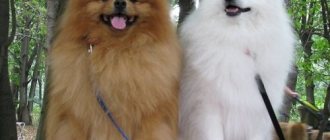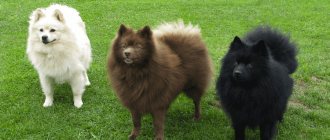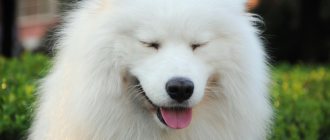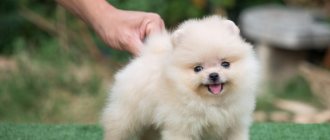The origin of the Spitz has several varieties and characteristics. Cute, cheerful dogs can hardly leave anyone indifferent. The history of the appearance of the breed is long and complicated.
During its existence, breeders selected the type in different ways, while Spitz dogs became widely known among people in various circles.
Where does this breed come from?
A country
The first mentions appeared in Northern Europe, however, it has not been possible to determine the country at the moment. There is a lot of controversy regarding the appearance of this type of dog in Germany and the Netherlands, however, there is no sufficient basis to establish the truth.
There is evidence that animals called differently in Germany and Holland belonged to the same breed. In Germany the name sounded like Wolfspitz, while in Holland it sounded like Keeshonda.
Years
Mentions of the species date back to different years. It is believed that Count Eberhard Say first mentioned the breed in his notes in 1450, and a professor from Cambridge gave the variety the Latin name Cannibus Brutanicus in 1570.
In 1867, Spitz dogs were very popular in Germany, as evidenced by the research of the German naturalist Fitzinger, who described 48 species of breeds in his works.
Purebred dog breeding began in Pomerania, a territory on the Baltic Sea coast.
Reference. Pomerania was assigned to the territory of Poland until the 10th century, and later became a province of Prussia.
Care and maintenance
Despite the Pomeranian's fluffy and long coat, you won't have to constantly groom it. It is enough just to follow a few rules in caring for the coat and there will be no problems, since the thickness of the undercoat perfectly supports itself and the guard villi.
We invite you to read: Tips and rules on how to measure a cat’s temperature. How to take a cat's temperature How to take a cat's temperature at home
You need to brush your dog twice a week. Brushing too often can remove the undercoat. Daily care will be needed during shedding and only with a massage brush.
You should bathe your pet only if it is heavily soiled, but not more than once a month. At other times, you can use dry dog shampoos and then gently comb the coat.
After walks, it will be enough to wipe the Spitz’s paws with a damp cloth and lightly brush against the grain.
The Pomeranian Spitz dog breed is quite unpretentious. Even an inexperienced dog breeder can handle caring for her. A pet can live both in a spacious house and in a small apartment - it can easily adapt to any conditions.
The right diet
Pomeranians can be fed commercial food or natural food. When choosing ready-made food, it is necessary to study the composition of dry food. They must contain at least 40% meat, vegetables, grains, and a complex of vitamins and minerals. Premium and superpremium or holistic products meet these requirements.
When feeding a Spitz dog naturally, the following is given:
- lean meats and offal;
- sea fish;
- porridge – rice, buckwheat, oatmeal;
- dairy products;
- fresh herbs, vegetables and fruits.
Pets are fed strictly according to schedule. Pomeranians are prone to obesity, so you should not give food in excess of the norm. Fat animals are susceptible to heart and joint disease, diabetes and cancer.
Story
The roots of the appearance of this species of animals go back to ancient times. The first mention of domestic dogs refers to a certain turf dog. Her remains were found in Switzerland, Scandinavia, and also in Russia.
The Peat Dog is considered the ancestor of the vast majority of different breeds in Europe. This species is considered to be the ancestor of modern Spitz.
The appearance of this type of dog is also mentioned in relation to the Samoyed, which, according to numerous opinions of researchers, is also considered the ancestor of the Spitz.
Among the inhabitants of Europe, such dogs were widespread, as evidenced by ethnographic finds, for example, ornaments on vessels for liquids.
Attention. Spitz dogs were bred to be a guard type, capable of signaling danger to their owner. Guard dogs were a subspecies of the German Spitz. The animal did not require significant costs for its maintenance, in comparison with other large dogs for protection.
The vast majority of dogs served as guards and were used to protect vineyards and scare away birds from ripened fruits. Spitz guarded farmland and barges in Württemberg in southwestern Germany. The guard type was characterized by a brown or black color.
Decorative Spitz dogs, in particular from Pomerania, were favorites of women, and their color was predominantly white.
By the end of the twentieth century, Spitz dogs had lost their original function as guard dogs. Today they remain popular as toy dogs and companion dogs.
How did German appear?
The variety is not only one of the oldest in Europe, but is also considered the ancestor of most other dog species.
The forefather of the German Spitz is considered to be the turf dog, which existed in the Stone Age.
This particular species belongs to watchdogs, because often used in the service of peasants. Until the 18th century, such animals were considered an economical option for a guard dog and could also perform herding functions.
The German Spitz gained popularity in the 18th century and was subject to various selections by breeders, reducing its size.
Subsequently, the German Spitz became a favorite of the German and English aristocracy. Queen Charlotte's pets were among the first to appear in the circle of the British monarchy. They were quite large and tall, white in color. The popularity of orange and brown colors appeared much later, by the beginning of 1900.
In the 19th century, the popularity of animals reached the United States, where the species was also subjected to selection. After which European and American pets began to differ greatly from each other within the same breed. Currently, a unified breed standard has been developed.
There are several height varieties of this type of dog:
- Wolfspitz or Keeshond, reaches from 23 to 55 cm at the withers;
- Grossspitz (large Spitz), height at the withers from 42 to 50 cm;
- medium Spitz, from 30 to 38 cm;
- small, height from 23 to 29 cm;
- miniature - from 18 to 22 cm.
Different colors are acceptable for each type.
Where did Pomeranian come from?
The category of dogs is decorative; the International Canine Federation considers the Pomeranian to be a variety of German. The American Kennel Club, on the contrary, distinguishes it as a separate breed.
They are named after the historical region of Germany - Pomerania, which at different times belonged to different states, in particular Poland.
In 1870, the breed from Germany came to England, where work began on its improvement: creating a dwarf form, improving the color and appearance of the coat, giving the appearance of exclusivity and sophistication.
Reference. The most famous owner of the Pomeranian Spitz was the English Queen Victoria, who took her faithful friend named Marco with her everywhere. Animals of this species have become an integral part of the entire high society of Europe.
Today this type of breed is divided into several types:
Dogs with a fox face represent the breed standard and can take part in exhibitions. The muzzle of this type is elongated, the eyes are almond-shaped, and the lower jaw is narrow;
babydoll - characterized by a wider and shorter muzzle than the standard type;
bear type - also a dwarf dog, with a shortened and flattened muzzle, round eyes and thick hair on the cheekbones.
The main difference between the types is the shape of the head, otherwise the dogs are very similar.
There are ten colors of oranges in total - from black to white and two-tone. Intermediate colors are blue and blue and tan, which makes these dogs stand out from the breed.
At the withers they can reach from 18 to 27 cm, while the weight of animals varies from 2.5 to 4 kg, on average.
Spitz character
Owners of charming Pomeranians note their good-natured character, unbridled curiosity and cheerful enthusiasm with which the fluffy buns explore the world even within the confines of an apartment. You should not get a Spitz as a decorative dog with whom you can lie on the couch and watch your favorite movie. The Pomeranian prefers active games, and a walk in the fresh air is a delight.
Spitz in a bicycle basket
The Pomeranian Spitz easily finds a common language with its owner, adapting to his lifestyle. A faithful dog will never make noise early in the morning if you prefer to get up around noon, and will follow on your heels as soon as you wake up. Representatives of this breed are attached to the family in which they live and can become sad if they are not given due attention.
Many Spitz owners note that returning home after work is fraught with a remarkable show of love from the little bear. The dog will always be by your side: while cooking dinner, taking a shower and sleeping at night. Some animals can sleep in the room with their owner (sometimes next to them on the bed) in order to please them in the morning with another portion of affection and a loud call to take a walk in the city park.
The Pomeranian has a tendency to bark and responds with a booming “voice” to any suspicious rustle. This dog makes an excellent watchman who will scare away an uninvited guest, forgetting about his miniature size. Sometimes a Spitz may bark for no reason, and then the owner will have to gently correct his pet’s habit.
We invite you to read: Life on Earth, theories of the origin of life on Earth - Space World
If you are planning to adopt a Pomeranian as a friend for your child, your attitude towards the new family member should be conscious and careful. Pomeranians will happily join children in a fun game if they are used to their company as a puppy. Otherwise, the dog will prefer to remain an outside observer.
The Pomeranian Spitz behaves reservedly with strangers and only in the absence of proper upbringing can it bark at a random passerby. The dog reacts warily to universal affection and not everyone will allow him to run his fingers through the soft plush fur.
The Spitz gets along well with other animals, but sometimes shows the habit of dominating its relatives. The appearance of a second dog in the house is an alarm bell for the Pomeranian: you need to show the owner and the new furry scoundrel who is boss in the house. However, if the Spitz grew up with other animals, these problems will not arise.
A description of a breed will be incomplete without an understanding of its character. Like other small dogs, he is quite short-tempered. The kid considers himself a formidable defender and is ready to fight an enemy larger than him.
In addition to reckless courage, the Spitz dog breed is distinguished by boundless devotion. Animals sincerely love all family members and suffer greatly if they are left alone for a long time. A cheerful pet never refuses games and walks.
Pomeranians are highly intelligent, but you need to find an approach to them. Representatives of the breed are stubborn and prone to dominance, so they should be trained by an experienced dog breeder.
The training and socialization of the puppy begins immediately after it adapts to the new place. The pet is taught:
- respond to name;
- relieve yourself on the street;
- follow the rules of cohabitation.
A little later, they begin to master the basic set of commands:
- at 2 months – “You can’t”, “Fu”, “Come to me”, “Sit”;
- at 3 months – “Lie down”;
- at 4 months – “Stand”;
- at 5-6 months - “You can”, “Wait”, “Walk”.
You can teach your Pomeranian various tricks - to speak on command, sit on its hind legs, etc. However, it is important not to overload your pet - classes should be short and varied.
Spitz and children
Pomeranians are great with children. It is better to trust your pet to teenagers who already know how to handle animals and understand their body language.
A small child will perceive the pet as a toy, which is dangerous for the fragile Pomeranian. The baby may accidentally injure the dog, and he will be forced to defend himself.
The Spitz is an intelligent, trainable dog. She loves children and becomes a wonderful friend to her owner. This breed wonderfully combines decorative appearance and lively character. The Spitz loves movement, he is always up for a walk and playing, and will never choose the sofa. With it you can throw a ball or a stick endlessly, this fluffy little ball will be wildly delighted. The Spitz needs physical activity not only for entertainment, but also for health - its past affects it. The dog also sometimes likes to bark.
Spitz dogs can be very stubborn, so they need to be trained from an early age. They have a tendency to dominate; dogs try to subjugate both a person and a larger dog. Notes of selfishness appear; when a new pet appears, there may be a manifestation of aggression and discontent. But once introduced, it gets along well with other animals.











